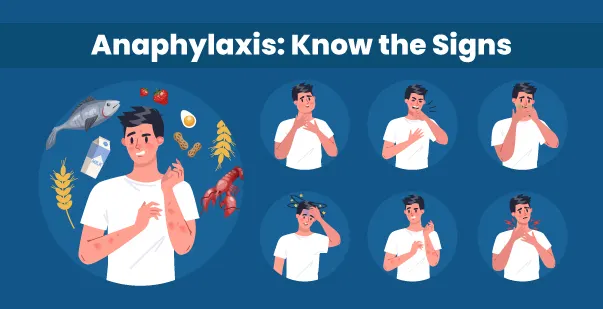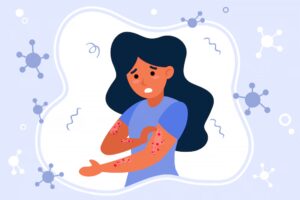
Last Updated On: March 27, 2025
Imagine enjoying your favorite meal or basking in the sunshine when suddenly, your body goes into full-blown crisis mode. That’s anaphylaxis! A severe allergic reaction that can be life-threatening and shows up without warning. It can happen in minutes when your immune system overreacts to something like peanuts, a bee sting, or even medication. What starts with hives can quickly escalate to trouble breathing or even shock.
It’s a medical emergency that requires fast action, but the good news is that with the right knowledge and preparation, you can manage anaphylaxis.
In this guide, we’ll cover the causes, symptoms, and treatments you need to know so that you can be ready. When it comes to allergies, knowing what to do can make all the difference!

Anaphylaxis signs and symptoms (Source)
| 💡 “Anaphylaxis” is derived from ancient Greek, where “ana” means “up” and “phylaxis” means “protection.” |
Anaphylaxis prevalence varies, but according to PubMed, up to 5% of Americans have experienced it. On a positive note, fatal cases contribute to less than 1% of the total mortality rate.
A study published in Wiley Online Library found that anaphylaxis cases in the U.S. skyrocketed from 153 per 100,000 in 2004 to 218 per 100,000 in 2016. Even more eye-opening? Women are 1.19 times more likely to develop it than men! This increase could be due to factors such as increased awareness, better diagnosis, changes in environmental triggers, or a true increase in allergic reactions.
If you know what anaphylaxis is and you understand the stages of the allergic reaction, you can recognize the symptoms quickly and get medical help. Here’s what happens in the stages of anaphylaxis:
You might notice redness, itching, or hives, and your nose could run. It may seem like a mild allergic reaction, but if you’re at risk for anaphylaxis, it’s important to take notice. The allergen triggers the release of histamine, which causes itching and swelling. Prostaglandins and leukotrienes contribute to blood vessel dilation and fluid leakage.
Symptoms worsen and spread. Hives cover your body, and swelling starts on your face, lips, and tongue. You might also experience difficulty swallowing, stomach pain, or diarrhea. Inflammatory mediators worsen inflammation, narrow the airways, and cause a drop in blood pressure, amplifying the reaction.
Breathing becomes difficult, and dizziness sets in. Swelling and a weak pulse indicate anaphylactic shock. Airway obstruction and low blood pressure severely limit oxygen delivery to tissues, causing metabolic acidosis. Inflammatory mediators activate blood clotting, further complicating the situation.
The allergic reaction escalates into a life-threatening condition. Despite your body’s attempts to compensate, the severity leads to cardiovascular collapse, respiratory failure, and multi-organ failure without immediate medical intervention.
The common anaphylaxis causes are:
Physical exercise and alcohol can also trigger an anaphylactic reaction in some cases, although the pathological mechanism is still poorly understood.
While anaphylaxis symptoms usually occur within a few minutes of exposure, anaphylactic shock can happen after 30 minutes or longe,r depending on how robust your immune system is.
At first, you may just feel “off,” as if things are not right with your body. Then, the most visible signs begin to manifest–itchy throat and skin, cough, light-headedness, stomach cramps, nausea, and diarrhea.
Watch out for the following signs and symptoms of anaphylaxis:
As described previously, all of these signs of anaphylaxis are caused by the release of histamine, prostaglandins, and cytokines in response to the allergen.
The signs of severe anaphylaxis include fainting, dizziness due to a drop in blood pressure (systolic pressure lower than 90 mmHg in adults), increased heart rate (by an average of 11.6%), and cardiac arrest.
Read more: Is CPR Just for Cardiac Arrest Victims?
Doctors diagnose anaphylaxis by examining your signs and symptoms.
If you want to recognize what anaphylaxis is and what is a normal allergic response, pay attention to these symptoms described previously.
Blood tests for histamine or tryptase are also useful to diagnose anaphylaxis due to drug allergies or insect stings. However, they are not useful for food allergies.
The anaphylaxis medication of choice is epinephrine. Doctors give it through intramuscular injection in the mid-anterolateral thigh at a dose of 0.3 to 0.5 mL of 1:1,000 concentration. For children, the dosing is 0.01 mg/kg or 0.15 mg intramuscularly.
Although most people only require a single dose to show improvement, doctors can give repeat doses every 5-10 minutes until symptoms get better.
Epinephrine works by reversing hypotension and swelling, relaxing airway muscles, and suppressing the release of more inflammatory mediators from basophils and mast cells.
Apart from this, other symptoms are managed in the following manner:
The doctor will check to see if the airways are clear. In anaphylaxis, edema and stridor are likely, so if they see any impending signs, they will work to secure the airway. However, for severe cases, tracheal intubation may be necessary.
After the airway is cleared, doctors will remove any contaminants, such as stingers, that may cause further allergic reactions.
Since the body has gone into shock, doctors will also administer IV fluids to restore blood volume and treat hypotension.
Along with these main lines of treatment, they may also offer adjunctive therapies to treat the symptoms.
In addition, doctors will give corticosteroids to reduce the length of anaphylaxis or prevent biphasic anaphylaxis (a second wave of symptoms that occurs hours or days after the first wave of symptoms goes away). It is either applied to the skin, given orally, or via intravenous (IV) injections. The medicines of choice are either methylprednisolone (80 – 125 mg IV) or hydrocortisone (250 – 500 mg IV).
To relieve milder symptoms like itching and hives, doctors give antihistamines. Most commonly, the H1 blocker diphenhydramine (25 – 50 mg IV) is given. For severe cases, they administer famotidine (20 mg IV) over two minutes or cimetidine (300 mg IV) along with diphenhydramine.
Doctors also administer bronchodilators like albuterol to reduce asthma-like symptoms (moderate wheezing or cough).
As anaphylaxis can become a life-threatening condition, you should be aware of the risk factors. Knowing what anaphylaxis is can help you take action quickly and also avoid situations where you may be exposed to your body’s triggers.
Subsequent reactions can be more severe due to sensitization, where the immune system “remembers” previous allergens and triggers a stronger response.
In the United States, approximately 1 in 50 Americans have experienced such life-threatening reactions. However, with proper knowledge and preventive measures, the risk of anaphylaxis can be significantly reduced.
People will be aware that you’re allergic to specific substances, and you can avoid unknowingly being exposed to them. For instance, if you’re allergic to peanuts, your server will tell you if the food you’ve ordered has peanuts in it.
In continuation to the first tip, you should always read food labels to make sure that it doesn’t contain food items you’re allergic to (e.g. eggs, nuts). At restaurants, you should ask if the dish you’ve ordered contains these food items. Also, ask about preparation methods, as they may prepare an allergen-free dish in a pan in which they have previously prepared a dish with allergens in it.
Doctors will usually ask you if you’re allergic to specific medicines, and you should also inform them if you’ve experienced an allergic reaction in the past.
Wear long-sleeved tops and full pants, and do not walk barefoot in the grass. If an insect appears near you, calmly back away from it. Do not try to swat it away with your hands. Also, do not drink from open soda cans when outdoors because insects tend to hover around them.
If you’ve previously experienced anaphylaxis, you should carry at least two doses of an epinephrine auto-injector, which is a prefilled pen (brand names: EpiPen/EpiPen Jr, Adrenaclick, AuviQ, Twinject) so that you can inject yourself (or a bystander can inject it for you).
Since epinephrine expires, you should take care to keep your prescription up-to-date.
Even if your symptoms improve after the injection, you should still go to the emergency room to make sure that the symptoms do not reoccur (biphasic anaphylaxis).
Remember to follow these steps to maximize the chances of recovering quickly from anaphylaxis:
On no account should you get up and attempt to walk away, even if you start to feel better. You should visit the hospital to get a thorough checkup to make sure you’re fully recovered.
Should a victim go into cardiac arrest due to anaphylactic shock, performing CPR can potentially save their life. Knowing what to do during the crucial few minutes of an emergency can change the prognosis of a victim.
Anaphylaxis is a severe allergic reaction that can escalate quickly, but with the right knowledge and preparedness, you can manage it effectively. Recognizing the symptoms early and understanding the causes are crucial for taking prompt action.
Diagnosing anaphylaxis often requires a thorough evaluation by a healthcare professional, but knowing how to treat it with epinephrine and other medical interventions can save lives.
Additionally, knowing CPR is vital in cases of anaphylaxis, as it can help maintain circulation and oxygen flow if the person goes into shock or stops breathing. By staying informed, learning CPR, and being prepared, you can reduce the risks and handle anaphylactic reactions confidently when they occur.
Haven’t undertaken CPR first aid card training yet? Don’t worry! You can easily choose an online basic first aid course that you can take at your convenience.
Read More: